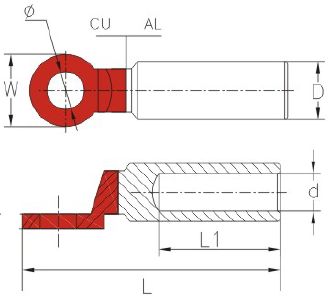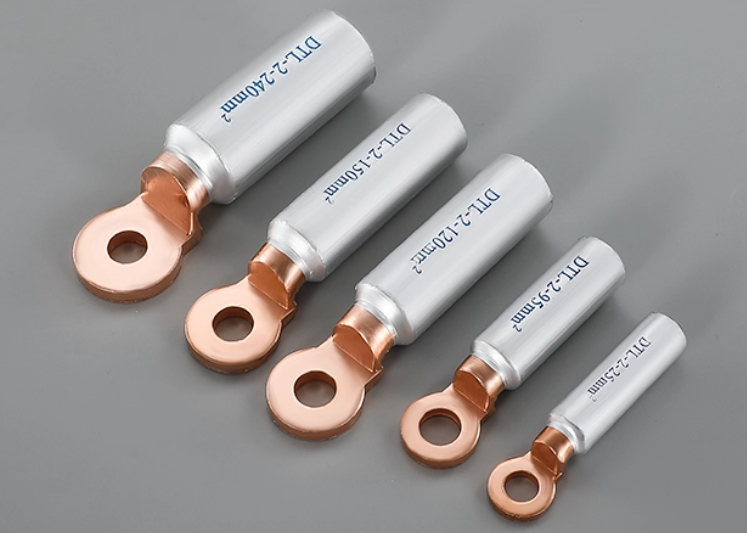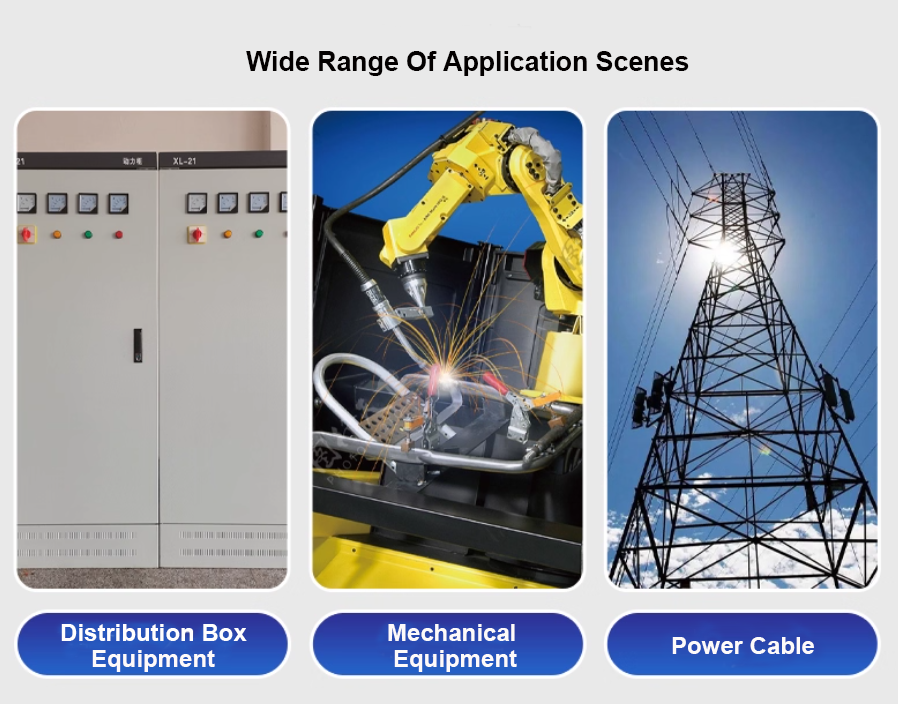| Availability: | |
|---|---|
| Quantity: | |
Introduction:
The DTL-2 Copper Aluminum Cable Lugs is a specific model of a bi-metallic terminal lugs, expertly engineered to create a safe and reliable
electrical and mechanical connection between aluminum conductors and copper-based equipment.
Material:Al≥99.5%,CU≥99.9%
Drawings:


Specificaitons:
Type | φ±0.3 | D±0.2 | d±0.2 | L±2 | L1±2 | W±0.2 |
DTL-2-10 | 13 | 16 | 5.2 | 80 | 44 | 20 |
DTL-2-16 | 13 | 16 | 6.5 | 80 | 44 | 20 |
DTL-2-25 | 13 | 16 | 7.5 | 80 | 44 | 20 |
DTL-2-35 | 13 | 16 | 9 | 80 | 44 | 20 |
DTL-2-50 | 13 | 20 | 10 | 90 | 44 | 24 |
DTL-2-70 | 13 | 20 | 11 | 90 | 44 | 24 |
DTL-2-95 | 13 | 20 | 12.5 | 90 | 44 | 24 |
DTL-2-120 | 13 | 25 | 15 | 118.5 | 60 | 30 |
DTL-2-150 | 13 | 25 | 15.5 | 118.5 | 60 | 30 |
DTL-2-185 | 13 | 32 | 18.5 | 120 | 60 | 35 |
DTL-2-240 | 13 | 32 | 20.5 | 125 | 60 | 35 |
DTL-2-300 | 13 | 34 | 22.5 | 132 | 72 | 36 |
DTL-2-400 | 17 | 40 | 27 | 141 | 72 | 36 |
DTL-2-500 | 17 | 40 | 29.5 | 141 | 72 | 36 |
DTL-2-630 | 17 | 47 | 34 | 185 | 100 | 45 |
Material & Construction:
This bimetallic Cable Lugs design, which is its most critical characteristic:
Barrel (Cable Crimping End): Made from high-purity aluminum. This is designed to be crimped directly onto an aluminum cable.
Sleeve and Eyelet (Connection End): Made from high-conductivity, tin-plated copper. The tin plating provides a reddish-orange color and
serves to enhance corrosion resistance and maintain a stable, low-resistance connection surface. The two materials are permanently and
molecularly bonded together using a specialized manufacturing process.

Key Features and Advantages:
Prevents Galvanic Corrosion: This is the primary purpose. Directly connecting dissimilar metals like aluminum and copper in the presence
of an electrolyte (like moisture) causes rapid galvanic corrosion, leading to connection failure, overheating, and potential fire hazards. The
DTL-2 lug isolates the aluminum conductor from the copper terminal, using a stable bi-metallic interface to eliminate this risk.
Excellent Electrical Conductivity: The high-pressure bond between the aluminum and copper components ensures a low-resistance path for
electrical current, minimizing voltage drop and heat generation.
Reliable Mechanical Connection: The aluminum barrel is designed for a secure compression crimp, often featuring serrations or indentations
to grip the cable firmly and prevent pull-out. The copper eyelet provides a robust point for bolted connections.
Durability: The tin-plating on the copper end resists oxidation and corrosion, ensuring long-term stability even in harsh environments.

Production Process:
The manufacturing is a precision operation, typically involving:
Extrusion: The aluminum barrel is often formed through an extrusion process to achieve its precise shape and internal structure.
Stamping and Forming: The copper component is stamped from sheet metal and then formed into its final sleeve and eyelet shape.
Plating: The copper part is electroplated with a layer of tin.
Bonding: The core step involves precisely aligning the aluminum and copper parts and subjecting them to high-pressure compression
(crimping) or a specialized welding process (like friction welding). This creates a cold weld, forming a permanent, molecular-level bond
that is both electrical conductive and mechanically strong.
Primary Applications:
This lug is essential in electrical power systems where aluminum cables must interface with copper components:
Power Distribution Panels: Connecting aluminum feeder cables to copper bus bars inside distribution boards and switchgear.
Transformer Connections: Linking aluminum transformer windings to copper terminal blocks.
Circuit Breakers and Disconnect Switches: Used to terminate aluminum cables to the copper lugs of these devices.
Industrial Wiring and Renewable Energy Systems: Commonly used in large-scale installations like solar farms or wind turbines where the cost
and weight savings of aluminum cables are significant, but the equipment requires copper termination points.


Introduction:
The DTL-2 Copper Aluminum Cable Lugs is a specific model of a bi-metallic terminal lugs, expertly engineered to create a safe and reliable
electrical and mechanical connection between aluminum conductors and copper-based equipment.
Material:Al≥99.5%,CU≥99.9%
Drawings:


Specificaitons:
Type | φ±0.3 | D±0.2 | d±0.2 | L±2 | L1±2 | W±0.2 |
DTL-2-10 | 13 | 16 | 5.2 | 80 | 44 | 20 |
DTL-2-16 | 13 | 16 | 6.5 | 80 | 44 | 20 |
DTL-2-25 | 13 | 16 | 7.5 | 80 | 44 | 20 |
DTL-2-35 | 13 | 16 | 9 | 80 | 44 | 20 |
DTL-2-50 | 13 | 20 | 10 | 90 | 44 | 24 |
DTL-2-70 | 13 | 20 | 11 | 90 | 44 | 24 |
DTL-2-95 | 13 | 20 | 12.5 | 90 | 44 | 24 |
DTL-2-120 | 13 | 25 | 15 | 118.5 | 60 | 30 |
DTL-2-150 | 13 | 25 | 15.5 | 118.5 | 60 | 30 |
DTL-2-185 | 13 | 32 | 18.5 | 120 | 60 | 35 |
DTL-2-240 | 13 | 32 | 20.5 | 125 | 60 | 35 |
DTL-2-300 | 13 | 34 | 22.5 | 132 | 72 | 36 |
DTL-2-400 | 17 | 40 | 27 | 141 | 72 | 36 |
DTL-2-500 | 17 | 40 | 29.5 | 141 | 72 | 36 |
DTL-2-630 | 17 | 47 | 34 | 185 | 100 | 45 |
Material & Construction:
This bimetallic Cable Lugs design, which is its most critical characteristic:
Barrel (Cable Crimping End): Made from high-purity aluminum. This is designed to be crimped directly onto an aluminum cable.
Sleeve and Eyelet (Connection End): Made from high-conductivity, tin-plated copper. The tin plating provides a reddish-orange color and
serves to enhance corrosion resistance and maintain a stable, low-resistance connection surface. The two materials are permanently and
molecularly bonded together using a specialized manufacturing process.

Key Features and Advantages:
Prevents Galvanic Corrosion: This is the primary purpose. Directly connecting dissimilar metals like aluminum and copper in the presence
of an electrolyte (like moisture) causes rapid galvanic corrosion, leading to connection failure, overheating, and potential fire hazards. The
DTL-2 lug isolates the aluminum conductor from the copper terminal, using a stable bi-metallic interface to eliminate this risk.
Excellent Electrical Conductivity: The high-pressure bond between the aluminum and copper components ensures a low-resistance path for
electrical current, minimizing voltage drop and heat generation.
Reliable Mechanical Connection: The aluminum barrel is designed for a secure compression crimp, often featuring serrations or indentations
to grip the cable firmly and prevent pull-out. The copper eyelet provides a robust point for bolted connections.
Durability: The tin-plating on the copper end resists oxidation and corrosion, ensuring long-term stability even in harsh environments.

Production Process:
The manufacturing is a precision operation, typically involving:
Extrusion: The aluminum barrel is often formed through an extrusion process to achieve its precise shape and internal structure.
Stamping and Forming: The copper component is stamped from sheet metal and then formed into its final sleeve and eyelet shape.
Plating: The copper part is electroplated with a layer of tin.
Bonding: The core step involves precisely aligning the aluminum and copper parts and subjecting them to high-pressure compression
(crimping) or a specialized welding process (like friction welding). This creates a cold weld, forming a permanent, molecular-level bond
that is both electrical conductive and mechanically strong.
Primary Applications:
This lug is essential in electrical power systems where aluminum cables must interface with copper components:
Power Distribution Panels: Connecting aluminum feeder cables to copper bus bars inside distribution boards and switchgear.
Transformer Connections: Linking aluminum transformer windings to copper terminal blocks.
Circuit Breakers and Disconnect Switches: Used to terminate aluminum cables to the copper lugs of these devices.
Industrial Wiring and Renewable Energy Systems: Commonly used in large-scale installations like solar farms or wind turbines where the cost
and weight savings of aluminum cables are significant, but the equipment requires copper termination points.

